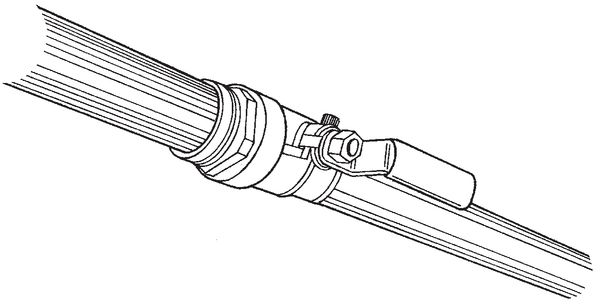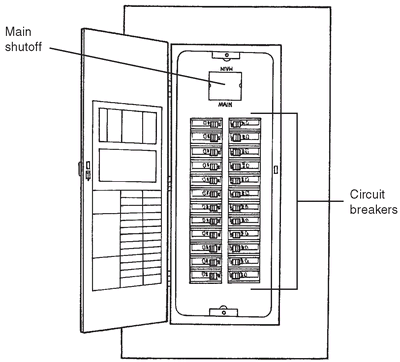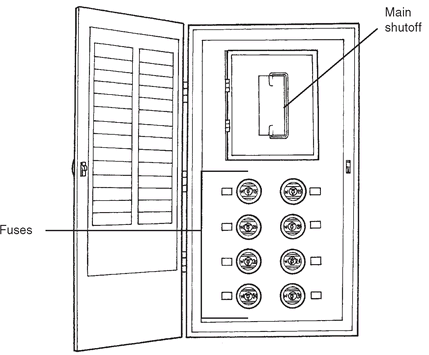Chapter 4
A Map of Your World
In This Chapter
• Locating the main controls for the systems in your house
• Starting and stopping water flow, whether it’s from a well or from an outside supplier
• Controlling your gas supply, and what to do if you suddenly smell gas
• Safe handling of your electrical panel
• Creating a personal home workbook
You need a lot of information to run a house. Unless you’re a person who leads a very simple life, your home has a plumbing system, an electrical system, and maybe a gas supply to heat your home or hot water. If you’re out in the country, you probably have a water well and a septic field, too.
Not to mention all those helpful appliances! They have plugs, hoses, switches, gaskets … a whole bunch of parts that may someday give you grief. And when one of them breaks down, you discover that you don’t really remember where you tossed that use and care manual; it might have come in handy, if you could find it!
This chapter will help you figure out how to get more control of all the equipment that helps you run your home. You’ll get some ideas about how to organize everything you should know about your house in a single location. It will make taking care of things a little bit easier.
The Main Thing: Your Home’s Power Centers
The least convenient time to search for the controls for your home’s water, gas, and electric service is when something suddenly goes very wrong. In the case of a gas leak, not understanding where and how service comes into your house can be life-threatening. So listen up!
Go to the stationery store, or with your own creative know-how, make labels or tags that say “Main Shutoff” for the primary gas and water valves in your house, as well as for the main electric service panel. Then follow the directions below and on the following pages so you can find, mark, and use them.
Basements are not always well-lit or easy to negotiate, so you’ll want to take along a flashlight for this activity. If you don’t have a basement, your utilities may be in a dedicated closet, or small room close to where the wires and pipes enter the house. Unless it’s well lighted, you’ll need a flashlight here, too.
Finding the Flow: Your Water Supply
If your water comes into the house from a municipal or private water company, there will be an outside shutoff for the water as it comes from the main pipe under the street onto your property and into your house. Don’t concern yourself with this control, as the shutoff can only be made by water company employees with special tools. (You should call the water company if an unusual flow of water near the street causes you to suspect a leak in the larger system.)
Find the water meter on the outside of your house; then look inside in a corresponding area for the water supply pipe that comes into the house.
The water control in an older home is often a gate valve with a round handle. In newer homes, the straight-handled ball valve has replaced the old-style control.
The gate valve works like any round handled faucet; a clockwise turn (or turns) shuts off the water supply, and counterclockwise turns restore the flow. There’s no need to play with it if you don’t need to shut off the water supply. When you do need to turn it off, if it’s difficult to turn, get your can of lubricant and give the valve a little squirt. If it still won’t budge, leave it alone and call the plumber.
Ball valves work differently. They are sturdy and long-lasting, and the best replacement for a worn gate valve. When the water supply is flowing, the handle is in-line (parallel) to the pipe. A quarter-turn (90°) shuts off the water. The ball valve turns off in only one direction, so don’t try to force it the wrong way.

Gate valve.

Ball valve in “on” position.

What Pros Know
Ball valves are a lot easier to operate than gate valves. Because main controls are operated infrequently, an old gate valve can become very hard to turn on and off. If you’ve got one of these antique numbers, and it’s looking worn, consider having a plumber replace it the next time you hire him for another job. It’s a nasty problem when the main gate valve starts leaking!
Once you’ve found your main water control, label it “Main Water Shutoff.” To make it easier to see in a dark basement, you might want to mark it with fluorescent tape.
Oh, Well
If you live in the country and do not have municipal water service, you’ll need to know where your well is located, and figure out where the supply pipe enters your house. The shutoffs will look the same as those for metered service, except that you don’t have a meter. Instead, you’ve probably got an electric pump, positioned deep in your well, that pumps water into holding tanks, and from there into your house.
A well supplies the water for my own house, but fixing the pump is not my kind of work. And the pump always decides to give us trouble on the holidays, when our well service man is otherwise engaged. Fortunately, these pumps are built to last, and breakdowns don’t happen often.
However, if a there’s a water leak in your house and you want to stop the flow of water, there’s an additional water/off option. You can use the main shutoff at the pipe, just as you would shut off the municipal supply, or you can go to your electrical panel (see more about this control later in the chapter) and shut off the circuit that controls the well pump.
Where the Well Water Goes
It has to go somewhere, and if you have a private water well that serves your home, chances are your wastewater goes to a septic tank and septic field on your property.
When you bought your house, if you have a septic system you should have gotten a map showing the location of your tank and field. If not, one should be on file at your county Board of Health.
The good news about septic systems is that they work very well—until they don’t. If you don’t have a company to pump out your septic tank, you should get one and use their services at recommended intervals. (These intervals are based on the number of occupants of your home; the Board of Health sizes septic fields based on the number of bedrooms.) Most septic service companies will put you on a schedule and call when you’re due for a pump-out. Do not neglect this regular service!
A septic system is a mess to repair, if the waste (effluent) is blocked from leaving your house via the waste line. And a failed septic system is a huge expense to replace. So make friends with a reliable septic system service company.
Your Gas System (Outside the House)
If you use natural gas for your heating system, hot water, clothes dryer, or stove, your supply also comes in from the street through a pipe that registers your usage at a meter outside the house. Just before the gas meter, you will see a shutoff valve that usually looks like a small, rectangular handle. When this control is parallel to the pipe, it means the gas is flowing. When it’s turned perpendicular (90˚) to the gas pipe, the gas is turned off.
The outside gas main control requires a wrench to turn it on and off. Like other outside controls for municipal and private utility service, in most cases the outside gas shutoff should only be turned on and off by gas company personnel, or the fire department.
If You Smell Gas
When natural gas comes out of the ground at its source, it has no color or smell. Companies that supply gas to consumers and businesses add the very noticeable odor of rotten eggs to gas so that a leak is easy to detect.
This is very important. If you should ever smell a strong odor of natural gas, do not use any devices that might make a spark. Light switches, phones, even turning on a flashlight could ignite the gas and cause an explosion.
Leave your home immediately and take anyone else in the house with you, including pets. Once you’re safely out of and away from the house, call the gas company or 911 from a neighbor’s house or your cell phone, if you’ve got one.
Other Gas Controls
There is sometimes a gas supply main control inside the house, in addition to the valve outside before the meter. It should be located close to where the gas supply comes into the house. This one (if you’ve got one) is usually a ball valve, operated in the same way as a water supply main ball valve: parallel to the pipe means the gas is flowing, and perpendicular to the pipe means the gas is off. Label this one “inside main gas control.” Like the water supply valve, you may want to use fluorescent tape on the label so it’s easy to see in a dark space.
Inside main gas supply control.

There are also individual controls for every gas appliance in your home. Usually they’re located on the metal supply pipe, where it connects to the flexible pipe that supplies the appliance. While the gas supply stops, as they are called, may have a slightly different look than the main supply ball valve, they work the same way.
def•i•ni•tion
Supply stops, also known as supply valves, are on/off controls found along household utility supply lines, managing the flow of gas or water to individual fixtures and appliances. Gas supply stops usually work on the principle of the ball valve, with the position in line with supply pipe indicating “on,” and a position perpendicular to the pipe indicating “off.” Supply stops for water fixtures usually work by turning the stops clockwise for shutoff, and counterclockwise for the open/on position. (Remember: righty, tighty; lefty, loosey.) The handles of water supply stops are usually round or oval, but sometimes older stops look like the gate valve pictured earlier in this chapter.
Propane is a gas derivative of the production of petroleum and natural gas, which is then compressed into a transportable liquid. Many rural homeowners who do not have access to natural gas pipelines use propane to power their gas appliances. Propane is stored in a tank outside the house and piped inside. There is a shutoff at the tank (reserved for the use of the propane service that you pay to keep the tank filled). Inside the house, appliances using propane will have supply stops at the juncture of the supply line and the appliance’s gas line. These stops will work the same way as supply stops for natural gas.
Propane is just as flammable as natural gas, and is treated to have the same rotten egg odor if it leaks into the air. If you detect the strong smell of gas, use the same extreme caution as you would with natural gas. Don’t fool around, get outside quickly, and call for help.
Your Electric Service
Before you reach for your flashlight to go figure out your home’s electrical system, remember that you need to use common sense when working around electrical wiring. Do not even touch the electric service panel if there is standing water in the room where it is located. Don’t use both hands to explore the panel; keep one at your side. Touching both hands to the panel completes a circuit (you!), and you don’t want to be the recipient of current gone astray. Take care!

Electric service panel: circuit breaker panel.
Depending upon how old your home is, your electrical controls will be located in a metal box containing fuses—which look like tubes or glass-topped plugs—or toggle switches, called circuit breakers. The toggle-switch type of circuit breaker meets current electrical code requirements and has been around for more than 40 years; you’ll find fuses in an older house. This metal box is connected to the large insulated wires that come into your house from the electric meter outside, and the electric company’s power grid beyond it. The box, called an electric service panel, or “breaker box,” is control central for the electric current that powers all the switches, receptacles, and light sockets in your home.
Fuse panel (aka fuse box).

def•i•ni•tion
A circuit breaker is a device that stops the flow of electricity in a circuit if there is too much current for safe operation. Both the toggle switches and the fuses used in the two types of service panels act as circuit breakers, but only the toggle-switch type are commonly referred to as circuit breakers. Toggle types move automatically to “off” in an overload. Fuses “blow”; that is, the metal strip inside the fuse melts from the overload. You will have to replace it with the same size and type of fuse.
If you have toggle-type circuit breakers, the main control that turns on and shuts off all the electric current for the house is often (but not always) located at the top of the service panel, above all the other circuit breakers. Sometimes, as in the previous illustration, the main toggle switch is enclosed with a little access door; open the door, and flip the switch to “off” to shut off. If you have fuses, you’ll find the main fuse at the top of the box. The main toggle in the circuit breaker panel will usually have a number on it, indicating the type of service coming into your home. This service is measured in amps (amperes), so you will usually see the main toggle marked 100, 150, or 200.
Occasionally the main control for the service coming into your house will be located in a different metal box, and sometimes a different location, than the service panel containing the toggle switches or fuses for separate circuits. If you can’t locate the main control—if it’s not obvious—then you need to call an electrician. They may be nice enough to direct you to the main by instructing you over the phone, or you may need to hire one to explain your system. Either way, you’re talking about electricity, so knowledge is much safer than ignorance here.
If you’re lucky, someone has taken time to clearly identify all the circuits in the house for you; each toggle switch or fuse is labeled with the rooms, switches, and receptacles, or appliances that each breaker or fuse controls. If not, or if they’re labeled ambiguously (for example, the previous owner marked a switch “Grandma’s bedroom,” so you can’t identify it), it’s a good idea to create a “map” of all the circuits in your house, then label the switches or fuses in the service panel or fuse box. When the lights shut off from a current overload in the future, you’ll be glad you took the time to do this. You’ll find instructions for creating a circuit map in Chapter 13.
A Workbook for Your Home
When something goes wrong with the workings of your house, you’ll find a lot of solutions in this book. But as you read, you’ll find that some instructions contain the words “often,” or “usually,” or “consult your owner’s manual.” That’s because every mechanical system and appliance may have parts or works that diverge from a certain reliable standard. Perhaps the switch you’re looking for is on the back of the appliance, not the front, where it is on 90 percent of the models most people see.
The more information you make available to yourself about your house, its systems, and all the appliances and conveniences it holds, the better able you will be to troubleshoot problems, judge which ones you can handle, and quickly assign the tough chores to the pros.
So, put it all together. Get yourself a 3-ring notebook with a wide spine (3 inches or more). The D-ring style holds pages flat most easily. If you have a lot of notebooks, buy this one in a color you can find quickly (red or yellow are highly visible). Fill it with those clear plastic sheet protectors—the kind that hold multi-page documents. If you want to be really organized, buy a pack or two of dividers, and label them with the name of each room and section of the house: kitchen, baths, bedrooms, living room, basement, attic, garage, and so on.
What will you put in this notebook? Let me give you a few ideas of basic things you can keep in it.
Appliance and Fixture Use and Care Manuals
Not every equipment problem signals the need for a repair or a service call. Sometimes you may have forgotten to turn a switch on or off. Maybe you’ve tried to start the device improperly. Use and care manuals contain instructions for assembling (when necessary), starting and stopping an appliance or fixture, and using it properly and safely. This handy guide usually has an illustrated diagram of the device, complete with the names and location of all its parts, including the label that will provide the model and serial numbers for your specific piece of equipment.
Often there’s a handy section on troubleshooting—that is, strategies for figuring out what’s wrong if something’s not working properly, usually followed by the manufacturer’s 800 helpline number or website URL. In addition, you’ll find a listing of authorized service representatives.
These manuals are great. If you’ve got them all in a drawer somewhere, transfer them to the sheet protectors in your notebook. If you’re really organized, file each one behind the divider you’ve labeled with the name of the room where the equipment is located.
If you’re not very organized, now’s the time to start. Those little instruction booklets can save you a lot of time!

What Pros Know
Can’t find the use and care manual for an appliance or piece of equipment? If you can locate the manufacturer name, model number, and serial number (usually listed on a label somewhere on the device), you may be able to find the manual from the manufacturer’s website. This is very possible if your equipment is fairly new, less so if it’s more than five to seven years old. Once you find the manual online, you can download and then print a hard copy of it to file in your workbook. (Be sure to have plenty of printer paper and an almost-full ink cartridge before you try to do this.) If an Internet search proves fruitless, try calling the manufacturer’s 800-number consumer help line.
Receipts and Manufacturer’s/Dealer’s Warranties
When something breaks down not long after you’ve purchased it, it may be covered for service or repair by the existing manufacturer’s warranty, or a warranty you purchased from the retailer when you bought the equipment. File your purchase receipt and a copy of the warranty with the use and care manual. If your device is covered, your tool kit can stay in its storage location. In fact, never try to repair something yourself when it is still under warranty; you’ll void the warranty. Call the number listed on the warranty; or call the dealer, if you purchased the warranty through the retail store.
Some manufacturers guarantee their equipment for life. I never believed I’d take someone up on this promise, and was doubtful that what was promised was indeed true (I can be cynical). But most companies who make this pledge turn out to actually mean it. When my very expensive, guaranteed-for-life kitchen faucet came apart after just a year, I called the manufacturer, and two days later, they had a new one delivered to my door!
Now, there must have been some serious flaw in the design (or in the user—me!) but the faucet broke again about two years later. And, true to its word, the manufacturer sent me another new faucet.
Make use of your lifetime guarantees! They’ll save you money and time.
Equipment Manuals or Schematics
Heating and cooling devices (furnaces, central air-conditioning units), water treatment units, and other big items that figure in the major operations of your home, may have been installed long before you arrived. In that case, you may be out of luck on obtaining a manual or a detailed drawing (called a schematic) that illustrates the equipment with labels for its parts. If you’ve got a drawing or manual, pop it in your workbook. It will help you when something goes wrong with your big systems. Down the road, if and when you sell the house, the buyer will appreciate this documentation.
A Circuit Map of Your Home
If your circuits are clearly labeled, copy the information on a piece of paper to keep in your home workbook. If they’re not, you should go to Chapter 13 as soon as you can and learn how to create this valuable map.
Service Records
When you do a repair on any equipment in your home, save the receipt. Make sure you or the professional service person notes the scope of the work and the date it was done. That way if a repair fails you’ve got a record, and you’ll know if you’ve got a chronic problem with something in your house.
File these records right behind the manuals and warranties you keep for the equipment.
Other Workbook Items
When you do a home improvement—install new carpet, paint a room, upgrade your kitchen—you can put the records and specifications, receipts, and manuals in the appropriate section of your workbook. This is particularly helpful when you’re looking to match paint or other materials to do a repair later on.
If you take the time to start it, and use it as information central for all the important components of your house, your personal home workbook will save you hours of time, and probably lots of money!
The Least You Need to Know
• The proper time to find out where to find the controls for your water, gas, and electric service is before there’s a problem—that is, right now.
• Label all the main shutoffs to make them easy to see and read.
• If you can’t locate your main controls, don’t hesitate. Call a pro who can help you find them.
• For easy reference, for saving time and money, and for troubleshooting problems, create a home workbook to keep your manuals, diagrams, and service and repair records in one place.
..................Content has been hidden....................
You can't read the all page of ebook, please click here login for view all page.
